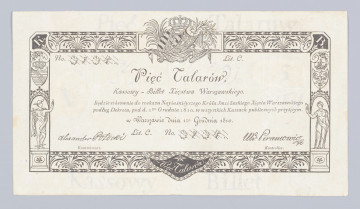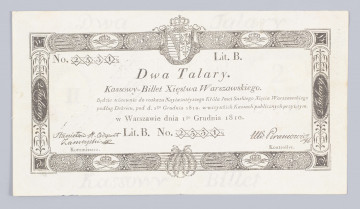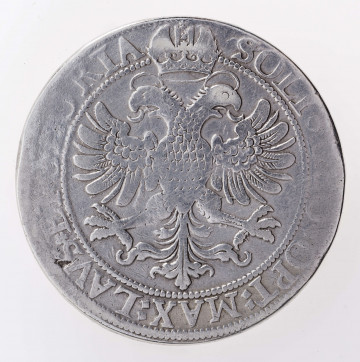
Treasury Ticket of the Duchy of Warsaw - 5 thalers
1810
National Museum in Lublin
Part of the collection: Paper money of the Kościuszko Uprising and the Duchy of Warsaw
Under the provisions of the Peace Treaty of Tilsit of 7 and 9 July 1807, Napoleon Bonaparte created the Duchy of Warsaw. Legally it was bound by a personal union with the Kingdom of Saxony, but it had a separate constitution, government, parliament, army and sovereign ruler in the person of Frederick Augustus I, grandson of Augustus III of Saxony. The actions of the Duchy's authorities were determined by the international situation, and more specifically by Napoleon Bonaparte's plans for Russia. The inevitability of war with the Russian Empire, to which the Polish population was pushing for the restoration of the former Polish-Lithuanian Commonwealth, placed a heavy economic burden on the inhabitants of the Duchy of Warsaw. The difficulties were exacerbated by financial obligations to France and by the fiscal mess. The territory of the Duchy of Warsaw was separated from the lands occupied mainly by Prussia in the second and third, and partly in the first partition. In 1809, it was enlarged by the Lublin and Kielce regions taken from Austria. As a result, the Prussian financial system was initially based on the thaler, which could easily be converted into zlotys at a rate of 1:6. As 1 zloty corresponded to 30 grosze, 1 thaler was equal to 180 grosze. The shortage of bullion money forced the Duchy authorities to turn to paper money, despite the bad experiences of the Kościuszko Uprising in this regard. The relevant decree issued by Frederick Augustus appeared on 1 December 1810. The issue was to be handled by a special independent commission attached to the Directorate of Treasury Tickets. It was decided to introduce tickets in the denominations of 1, 2 and 5 thalers. The first tickets of all denominations were issued on 2 July 1811. Their modest graphic design was quite similar. It was limited to a decorative frame. In the middle of its upper part the coat of arms of the Duchy of Warsaw was placed. Banknotes circulating in the Kingdom of Saxony were used as a model. There the Polish tickets were designed by unknown authors. The money was printed in Dresden.
The 1-thaler banknotes were issued in an edition of 700,000 pieces with a value of 4,200,000 Polish zloty. All of them were printed on quite thin, white paper, within one series marked with the letter A. The presented piece is number 6878, so it comes from the initial stage of production.
Leszek Poniewozik
Author / creator
Dimensions
cały obiekt: height: 95 mm, width: 174 mm
Object type
paper money
Technique
typography
Material
paper
Creation time / dating
Creation / finding place
Owner
The National Museum in Lublin
Identification number
Location / status

1810
National Museum in Lublin

1810
National Museum in Lublin

1621
National Museum in Lublin
DISCOVER this TOPIC
National Museum in Szczecin
DISCOVER this PATH
Educational path